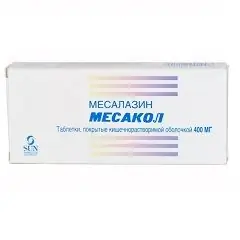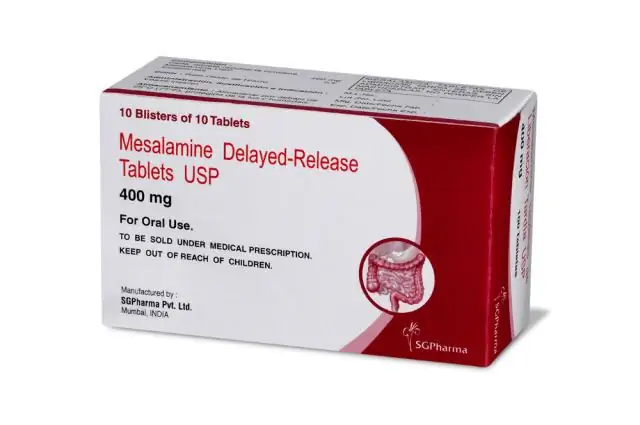- Author Rachel Wainwright [email protected].
- Public 2023-12-15 07:39.
- Last modified 2025-11-02 20:14.
Mesacol
Mesakol: instructions for use and reviews
- 1. Release form and composition
- 2. Pharmacological properties
- 3. Indications for use
- 4. Contraindications
- 5. Method of application and dosage
- 6. Side effects
- 7. Overdose
- 8. Special instructions
- 9. Application during pregnancy and lactation
- 10. Use in childhood
- 11. In case of impaired renal function
- 12. For violations of liver function
- 13. Drug interactions
- 14. Analogs
- 15. Terms and conditions of storage
- 16. Terms of dispensing from pharmacies
- 17. Reviews
- 18. Price in pharmacies
Latin name: Mesacol
ATX code: A07EC02
Active ingredient: mesalazine (mesalazine)
Manufacturer: Sun Pharmaceutical Industries Ltd. (India)
Description and photo update: 2018-23-10
Prices in pharmacies: from 425 rubles.
Buy

Mesakol is an anti-inflammatory and antimicrobial intestinal drug.
Release form and composition
Mesacol is produced in the form of enteric-coated tablets: round, brownish-red, biconvex (10 pcs. In aluminum strips, 5 strips in a cardboard box).
1 tablet contains:
- active substance: mesalazine (5-aminosalicylic acid, or 5-ASA) - 0.4 g;
- auxiliary components: povidone K90, calcium hydrogen phosphate dihydrate, colloidal silicon oxide, corn starch, sodium carboxymethyl starch (type A), microcrystalline cellulose, Eudragit L-100-55 (copolymer of methyl methacrylate type "C" and methacrylic acid), eudromellose S 2208 -100 (copolymer of methyl methacrylate type "B" and methacrylic acid), dibutyl phthalate, iron oxide red, titanium oxide, macrogol 6000, purified talc.
Pharmacological properties
Pharmacodynamics
Mesakol has anti-inflammatory and antimicrobial effects, which are mainly localized in the intestines. The therapeutic effect of the drug is due to inhibition of the activity of neutrophilic lipoxygenase and the synthesis of leukotrienes and prostaglandins. In addition, the anti-inflammatory effect of the drug is manifested in the inhibition of migration, degranulation, phagocytosis of neutrophils, secretion of immunoglobulins by lymphocytes. Antimicrobial activity is manifested in the large intestine against some cocci and Escherichia coli.
Pharmacokinetics
The release of mesalazine begins approximately 2-3 hours after taking the tablet, its complete dissolution occurs after 3-4 hours. The presence of a special shell provides the active substance with the movement to the large intestine, where it is mainly released (60-79%). In the middle section of the small intestine (jejunum), 15-30% mesalazine is released. The concentration of the drug in the blood plasma is low, since no more than 10% enters the systemic circulation.
Plasma protein binding - 43%.
Metabolism of mesalazine occurs in the intestinal mucosa and in the liver with the formation of N-acetyl-5-aminosalicylic acid, binding to the metabolite is approximately 73-83%. Mesacol and N-acetyl-5-aminosalicylic acid are excreted in breast milk.
The half-life (T 1/2) of mesalazine depends on the dose taken and can be from 0.5 to 2 hours, the metabolite - from 5 to 10 hours.
50% of the drug is excreted through the kidneys, 40% through the intestines.
In chronic renal failure, the drug accumulates.
Indications for use
According to the instructions, Mesakol is indicated for the prevention of exacerbations and the treatment of the following diseases:
- ulcerative colitis (ulcerative colitis);
- Crohn's disease.
Contraindications
- peptic ulcer of the stomach and duodenum;
- hemorrhagic diathesis;
- severe liver failure;
- severe renal failure;
- blood diseases;
- deficiency of glucose-6-phosphate dehydrogenase;
- breast-feeding;
- childhood;
- hypersensitivity to the components of the drug.
Caution should be exercised when prescribing Mesacol to patients with mild to moderate renal failure, mild to moderate hepatic failure, during pregnancy.
Instructions for the use of Mesacol: method and dosage
Mesacol tablets are taken orally, after a meal, swallowing whole and drinking plenty of water.
Recommended dosage:
- treatment of the acute form of the disease: 1-2 pcs. (0.4-0.8 g) 3 times a day. The duration of the course is 8-12 weeks;
- prevention of exacerbations: 1 pc. 3 times a day.
Side effects
- from the digestive system: dry mouth, heartburn, nausea, vomiting, abdominal pain, diarrhea (more often with high doses), decreased appetite, stomatitis, pancreatitis, increased activity in the blood plasma of hepatic transaminases, hepatitis;
- from the central nervous system: tinnitus, headache, dizziness, insomnia, polyneuropathy, convulsions, hallucinations, tremors, depression;
- from the cardiovascular system: chest pain, palpitations, arterial hypotension or hypertension, tachycardia, shortness of breath; in some cases - cardiac conduction disorders, pericarditis;
- from the hematopoietic system: megaloblastic, hemolytic or aplastic anemia, eosinophilia, thrombocytopenia, hypoprothrombinemia, agranulocytosis;
- from the urinary system: hematuria, crystalluria, proteinuria, oliguria, nephrotic syndrome, anuria;
- allergic reactions: bronchospasm, dermatoses, skin rash, itching, erythema;
- from the reproductive system: oligospermia; in some cases - impotence;
- others: photosensitivity, weakness, mumps, lupus-like syndrome, decreased production of tear fluid, alopecia.
Overdose
Symptoms: weakness, nausea, vomiting, drowsiness, gastralgia.
Treatment: the patient should immediately wash the stomach, take a laxative. If necessary, symptomatic therapy is performed.
special instructions
Since diarrhea is one of the symptoms of major diseases, its development should not always be attributed to the unwanted effects of the drug.
Before starting treatment, during and after taking Mesacol, it is advisable to conduct a general blood test and control the excretory function of the kidneys.
If symptoms appear that indicate the development of acute intolerance syndrome, the drug must be canceled.
The risk of developing adverse events while taking mesalazine increases in patients with low activity of acetylating enzymes.
Patients should be informed that taking Mesacol may cause lacrimal fluid (including soft contact lenses) and urine to become yellow-orange.
The recommended dosing regimen should not be violated; if the next dose is accidentally missed, it should be taken at any time, including with the next dose. If several doses are missed, the patient should consult a doctor without stopping taking the pills.
Application during pregnancy and lactation
During gestation, Mesakol is prescribed only in the exceptional case when the expected effect of therapy for the mother, in the opinion of the doctor, is higher than the potential risk to the fetus.
The use of mesalazine during breastfeeding is contraindicated. If necessary, taking the drug during lactation, breastfeeding should be discontinued.
Pediatric use
Do not prescribe Mesacol tablets in childhood.
For the treatment of children, mesalazine should be used in the form of suppositories, microclysters or suspension.
With impaired renal function
The appointment of Mesacol is contraindicated in severe renal failure.
With mild to moderate renal failure, tablets should be taken with caution.
For violations of liver function
The drug is contraindicated for severe hepatic failure.
With mild to moderate hepatic impairment, Mesacol should be used with caution.
Drug interactions
With the simultaneous use of Mesacol:
- methotrexate increases its toxicity;
- sulfonylurea derivatives enhance the hypoglycemic effect; glucocorticosteroids increase the risk of side effects associated with the formation of defects in the mucous membrane of the gastrointestinal tract;
- sulfonamides, furosemide, spironolactone, rifampicin weaken their therapeutic effect;
- anticoagulants increase their activity;
- cyanocobalamin slows down its absorption;
- uricosuric agents (tubular secretion blockers) increase the effectiveness of their action.
Since the release of the active substance from the tablet does not occur at a low acidity (pH) level, they cannot be administered in combination with drugs that lower the pH of the stomach.
Analogs
Analogs of Mesakol are: Salofalk, Sulfasalazine, Salazopyridazine, Mesalazin, Asakol, Samezil, Pentasa.
Terms and conditions of storage
Keep out of the reach of children.
Store at temperatures up to 25 ° C, protected from light and moisture.
Shelf life is 4 years.
Terms of dispensing from pharmacies
Dispensed by prescription.
Reviews about Mesacol
Reviews of Mesacol in most patients are positive. Patients with nonspecific ulcerative colitis, forced to take mesalazine preparations for the prevention of exacerbations of the disease for a long period, note a sufficient therapeutic effect, prolonged remission, and a lower cost of the drug compared to similar drugs.
In some patients, taking pills causes the development of side effects that require their withdrawal.
Price for Mesacol in pharmacies
The price of Mesacol for a pack of 50 tablets can range from 976 rubles.
Mesacol: prices in online pharmacies
|
Drug name Price Pharmacy |
|
Mesacol 400 mg enteric-coated tablets 50 pcs. 425 RUB Buy |
|
Mesacol tablets p.p. 400mg 50 pcs. 683 r Buy |

Anna Kozlova Medical journalist About the author
Education: Rostov State Medical University, specialty "General Medicine".
Information about the drug is generalized, provided for informational purposes only and does not replace the official instructions. Self-medication is hazardous to health!






